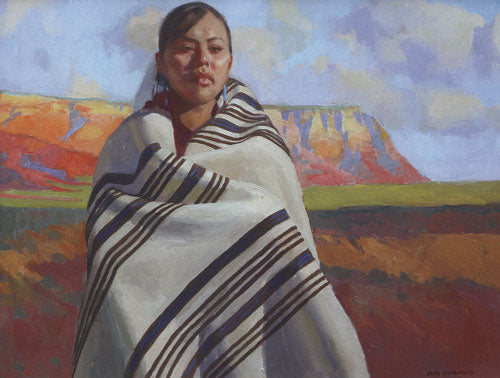Ray Roberts
By Medicine Man Gallery on

Ray Roberts: High Desert Warmth
California artist Ray Roberts latest Native American-themed paintings revolve around early Navajo blankets, some dating back to the 1860s.
Pubished online courtesy Western Art Collector, August 2010

Ray Roberts, High Desert Warmth, oil on canvas, 30"x40"
California artist Ray Roberts latest Native American-themed paintings revolve around early Navajo blankets, some dating back to the 1860s. The figure in this grouping become models of these cultural icons and the landscape their runway. The majority of blankets shown are based on Roberts’ access to the extensive collection of Mark and Kathleen Sublette of Medicine Man Gallery, which will present Roberts’ new work in its Santa Fe showroom through August 16.
“In many ways these are paintings of paintings. With that said, I’m dealing with a variety of approaches and personal challenges in color and concept surrounding figures wrapped in these blankets,” says Roberts. “My approach to this group of paintings has been to pay more attention to these specific weaves and at the same time make a statement about the landscape. It’s been a stimulating experience.”
Roberts relies on reference photos and his knowledge of these detailed blankets and the colorations to provide a starting point. Some of the new oil paintings reflect the artist’s internal dialog about red and green because that relates to how we see color.
“It’s the way we see light optically as opposed to primary colors and the more widely accepted approach to painting,” he says.

Ray Roberts, Transitional, oil on canvas, 30"x24"
Transitional and Navajo with Transitional Blanket, two high-key pieces of similar size and format, contain these warm colorations and a standing solitary figure looking straight ahead wrapped in a transitional blanket. The title refers to the design pattern circa 1890s.
Dr. Mark Sublette of Medicine Man Gallery says, "Versatlity best describes Ray Roberts painting ability. An artist whose style can seamlessly switch between a great landscape and contemplative figurative work without ever losing the essence of the West."
In other works, Roberts challenges his abilities to capture light and atmosphere in a variety of weather conditions such as storms, wind, bright light, evening, etc., as illustrated in High Desert Warmth in which he depicts a blanket blowing in the wind as a storm approaches. In Evening Warmth he depicts inclement weather yet makes the lighting very ethereal.
“The challenge in that is that I’m deviation from the information I have,” says Roberts. “I’m interpreting it to give the effect of these different situations.”

Ray Roberts, Indigo, oil on linen panel, 18"x24"
The artist also challenges himself with a new motif in the Southwest genre integrating petroglyphs with a contemporary figure in the landscape, as illustrated in Painted Stories.
“The petroglyphs add an extra dimension of prehistoric peoples, shamanism and an element of mystery surrounding the solitary figure,” explains Roberts. “Although the connection between Anasazi and Diné is not direct, there’s a larger story here of existentialism and converging cultures of the first Americans in the area.”

Ray Roberts, Painted Stories, oil on canvas, 24"x36"
Roberts hopes this collection resonates with others who share his appreciation of the artistry and craftsmanship of these blankets, the Diné, their land and culture.
“I want collectors to look at the paintings as concepts and visages somewhat beyond the two-dimensional surface of the painting. I try to work that direction in all my work,” he says.
Roberts is quick to credit the Navajo weavers who created these masterful pieces that are now the subject of his canvases.
“These blankets were so coveted and recognized for their artistic merit that they were collected by other Native Americans even before the United States existed. With that said, each painting has its own provenance so to speak. Where one painting may have more success visually, intent and content will be different concerning the artistry of the blankets and the painting. Some of these blankets took nearly a year to weave,” explains Roberts. “The experiences and vision quests of the petroglyphs also have an innate artistic sense about them. The artistry in these images and blankets is beyond what I can place judgment on. I may add my interpretation of these early original artworks, but for the most part the artistry is already there and I am simply recording it.”